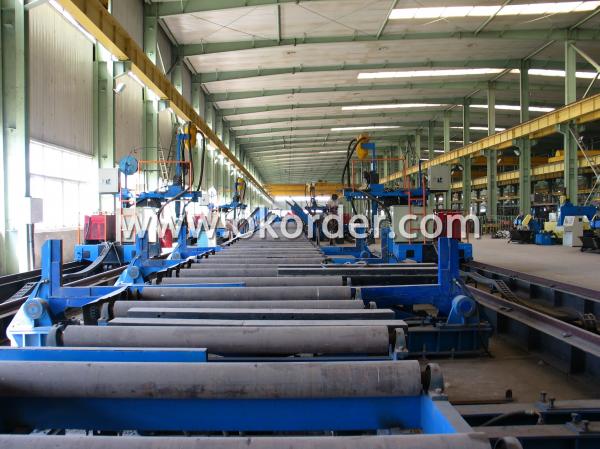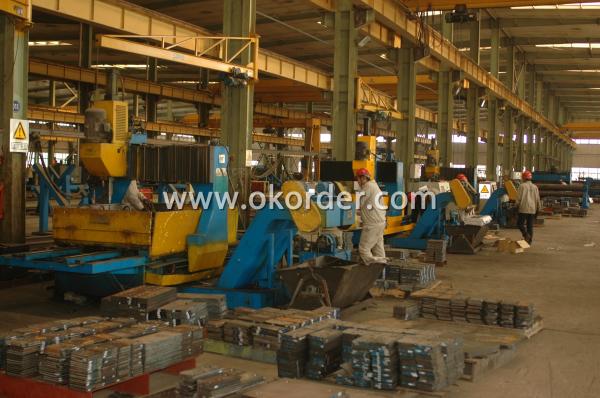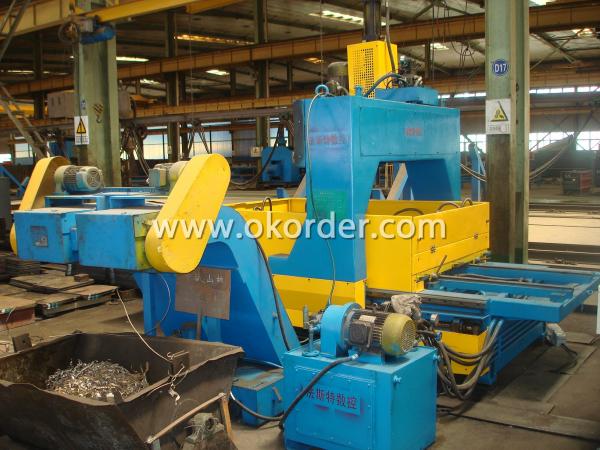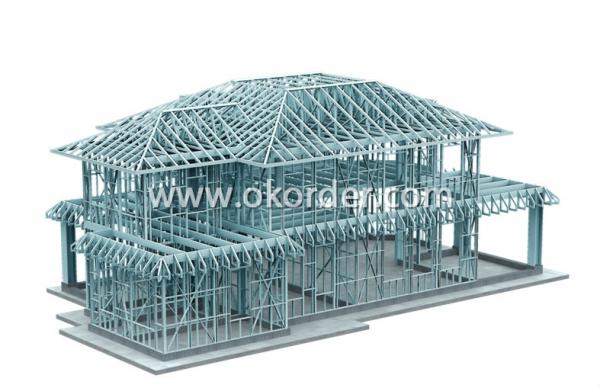Metal Building Steel Structure
- Loading Port:
- China Main Port
- Payment Terms:
- TT or LC
- Min Order Qty:
- 1000MTONS m.t.
- Supply Capability:
- 5000MTONS/MONTH m.t./month
OKorder Service Pledge
OKorder Financial Service
You Might Also Like
Specifications of metal building steel structure
Project type : business building steel structure(shopping mall)
Designer:P&T Group
Consultant : Manusell consultants
Structure type :Box, tube, complex spatial structure
Building area: 52600 square meters
Quantities: 5000 t
1. GB standard material
2. High Structural safety and reliability
3. The production can reach GB/JIS/ISO/ASME standard
Packaging & Delivery of metal building steel structure
1. According to the project design and the component size, usually the main component parts are nude packing and shipped by bulk vessel. And the small parts are packed in box or suitable packages and shipped by containers.
2. This will be communicated and negotiated with buyer according to the design.
Engineering Design Software of metal building steel structure
Tekla Structure \ AUTO CAD \ PKPM software etc
⊙Complex spatial structure project detailed design
⊙Construct 3D-model and structure analysis. ensure the accuracy of the workshop drawings
⊙Steel structure detail ,project management, automatic Shop Drawing, BOM table automatic generation system.
⊙Control the whole structure design process, we can obtain higher efficiency and better results
Technical support of metal building steel structure
|
Worker |
Rate of frontline workers with certificate on duty reaches 100% |
|
Welder |
186 welders got AWS & ASME qualification 124 welders got JIS qualification 56 welders got DNV &BV qualification |
|
Technical inspector |
40 inspectors with UT 2 certificate 10 inspectors with RT 2 certificate 12 inspectors with MT 2 certificate 3 inspectors with UT3 certificate |
|
Engineer |
21 engineers with senior title 49 engineers with medium title 70 engineers with primary title. 61 First-Class Construction Engineers 182 Second-Class Construction Engineers |
|
International certification |
10 engineers with International Welding engineer, 8 engineers with CWI. |
Production Flow of steel structure/metal building
Material preparation—cutting—fitting up—welding—component correction—rust removal—paint coating—packing—to storage and transportation (each process has the relevant inspection)
 |
 |
|
steel structure H-beam welding line |
steel structure cutting (blanking) |
 |
 |
|
steel structure plate shearing machine |
steel structure drilling |
*Characters of Structure Steel
1. Steel is characterized by high strength, light weight, good rigidity, strong deformation capacity, so it is suitable for construction of large-span, super high and super-heavy buildings particularly;
2. It with good homogeneous and isotropic, is an ideal elastomer which perfectly fits the application of general engineering;
3. The material has good ductility and toughness, so it can have large deformation and it can well withstand dynamic loads;
4. Steel structure’s construction period is short;
5. Steel structure has high degree of industrialization and can realize-specialized production with high level of mechanization.
*Steel structure application
1. Heavy industrial plants: relatively large span and column spacing; with a heavy duty crane or large-tonnage cranes; or plants with 2 to 3 layers cranes; as well as some high-temperature workshop should adopt steel crane beams, steel components, steel roof, steel columns, etc. up to the whole structure.
2. Large span structure: the greater the span of the structure, the more significant economic benefits will have by reducing the weight of the structure
3. Towering structures and high-rise buildings: the towering structure, including high-voltage transmission line towers, substation structure, radio and television emission towers and masts, etc. These structures are mainly exposed to the wind load. Besides of its light weight and easy installation, structure steel can bring upon with more economic returns by reducing the wind load through its high-strength and smaller member section.
4. Structure under dynamic loads: As steel with good dynamic performance and toughness, so it can be used directly to crane beam bearing a greater or larger span bridge crane
5. Removable and mobile structures: Structure Steel can also apply to movable Exhibition hall and prefabricated house etc by virtue of its light weight, bolt connection, easy installation and uninstallation. In case of construction machinery, it is a must to use structure steel so as to reduce the structural weight.

6. Containers and pipes: the high-pressure pipe and pipeline, gas tank and boiler are all made of steel for the sake of its high strength and leakproofness
7. Light steel structure: light steel structures and portal frame structure combined with single angle or thin-walled structural steel with the advantages of light weight, build fast and steel saving etc., in recent years has been widely used.
8. Other buildings: Transport Corridor, trestle and various pipeline support frame, as well as blast furnaces and boilers frameworks are usually made of steel structure.
All in all, according to the reality, structure steel is widely used for high, large, heavy and light construction.
- Q:How are steel structures tested for structural integrity?
- Steel structures are tested for structural integrity through a series of rigorous assessments and evaluations. The main goal of these tests is to ensure that the structure can withstand its intended design loads, such as gravity, wind, seismic, and other environmental factors. One common method used in testing steel structures is the load testing. This involves applying incremental loads to specific areas of the structure to measure its response and determine its load-carrying capacities. This can be done using hydraulic jacks, weights, or other load application methods. The structure's deflection, deformation, and stress levels are closely monitored during the testing process to ensure that it remains within acceptable limits. Non-destructive testing (NDT) techniques are also employed to assess the structural integrity of steel structures. These techniques include ultrasonic testing, magnetic particle testing, liquid penetrant testing, radiographic testing, and visual inspection. NDT methods can detect any defects, cracks, or weaknesses in the steel components without causing any damage to the structure. This helps identify potential areas of concern that may compromise the structure's strength and durability. In addition to load testing and NDT, computer-aided engineering (CAE) tools are widely used to simulate and analyze the behavior of steel structures. Finite element analysis (FEA) is a common CAE technique that models the structure and applies virtual loads to assess its structural response. This allows engineers to identify potential weak points, optimize designs, and make necessary modifications to ensure the structure's integrity. Overall, testing steel structures for structural integrity involves a combination of physical load testing, non-destructive testing, and computer simulations. These comprehensive methods help ensure that steel structures meet the required safety standards and have the necessary strength and durability to withstand various loads and environmental conditions.
- Q:How do steel structures perform in earthquake-prone areas?
- Steel structures perform very well in earthquake-prone areas due to their inherent strength, flexibility, and ductility. Steel is a material that can withstand high amounts of stress and has a high strength-to-weight ratio, making it ideal for withstanding the forces generated during an earthquake. One of the key advantages of steel structures is their ability to flex and deform without collapsing. This flexibility allows the structure to absorb and dissipate the seismic energy, reducing the impact on the building and its occupants. The ductility of steel also enables it to undergo large deformations without losing its load-carrying capacity, ensuring the overall integrity of the structure. Moreover, steel structures can be designed to have redundancies and bracing systems that enhance their seismic performance. This includes using moment-resisting frames, diagonal bracing, and other structural elements that help distribute the seismic forces and minimize damage. These design features allow steel structures to withstand even strong earthquakes, minimizing the risk of collapse and ensuring the safety of occupants. Additionally, steel structures can be prefabricated offsite, allowing for high precision and quality control during construction. This ensures that the building is constructed to the highest standards, which is crucial in earthquake-prone areas where structural integrity is of utmost importance. Overall, steel structures have a proven track record of performing exceptionally well in earthquake-prone areas. Their strength, flexibility, and ductility make them a reliable choice for ensuring the safety and resilience of buildings in seismic zones.
- Q:How are steel structures designed for different HVAC systems?
- Steel structures are designed for different HVAC systems by considering factors such as load requirements, system placement, and ventilation needs. The design process involves assessing the weight and size of the HVAC equipment, ensuring proper support and stability within the steel structure. Additionally, the structural design takes into account the airflow requirements, ductwork layout, and access points for maintenance and repairs. Overall, steel structures are tailored to accommodate the specific needs and specifications of different HVAC systems.
- Q:What are the factors considered in determining the size and shape of steel members in a structure?
- The factors considered in determining the size and shape of steel members in a structure include the structural load requirements, such as the magnitude and nature of the loads acting on the member, the type of structure and its intended use, the span length, the desired deflection limits, the connection details, and any applicable building codes and regulations. Additionally, the material properties of the steel being used, such as its yield strength and elasticity, also play a crucial role in determining the appropriate size and shape of the steel members.
- Q:How do steel structures contribute to the overall speed of construction?
- There are several ways in which steel structures speed up construction. To begin with, steel is a lightweight material that is easy to handle and transport, enabling faster construction. Unlike concrete and other materials, steel structures can be manufactured off-site and then quickly assembled on-site, reducing the time needed for on-site construction activities. Moreover, steel structures offer great versatility and can be prefabricated to precise dimensions, ensuring high accuracy and minimizing the need for on-site adjustments. This precise fabrication allows for faster assembly and installation, as the components can be easily fitted together without extensive on-site modifications. Additionally, steel structures are renowned for their strength and durability. This means that fewer support columns and load-bearing walls are required, resulting in more open and flexible interior spaces. With fewer supporting elements, construction can proceed more rapidly, as there is less time spent on laying foundations and constructing walls. Furthermore, steel structures can be erected in any weather conditions, as the material is unaffected by moisture or extreme temperatures. This eliminates weather-related delays, which can occur with other construction materials, and contributes to a faster construction timeline. Lastly, steel structures are highly adaptable and can be easily modified or expanded. This flexibility allows for quick and efficient future modifications or additions, without the need for extensive demolition or reconstruction. This adaptability enhances the overall speed of construction by enabling easy alterations or expansions to be incorporated without disrupting the existing structure. In conclusion, steel structures speed up construction through their lightweight nature, precise fabrication, strength and durability, resistance to weather conditions, and flexibility for future modifications. These characteristics make steel structures the preferred choice in many construction projects, due to their ability to facilitate faster construction times.
- Q:What are the common challenges in designing steel structures?
- Designing steel structures poses its fair share of challenges. Engineers and designers commonly face the following obstacles: 1. Structural Integrity: Ensuring the steel structure's structural integrity is crucial. It must withstand various forces throughout its lifespan, such as wind, earthquakes, and heavy loads. Accurately calculating and predicting these forces can be difficult. 2. Material Selection: Selecting the appropriate steel grade and quality is vital. Different steel grades have different properties and strengths, and choosing the wrong grade can jeopardize the structure's safety and durability. Factors like corrosion resistance, toughness, and weldability must be considered during steel selection. 3. Connection Design: Designing and detailing the connections between steel members properly is critical. Connections must be strong enough to efficiently transfer loads without compromising overall structural stability. Designers need to consider forces, moments, and tolerances during connection design. 4. Fabrication and Construction Constraints: Designing a steel structure must take into account the limitations and capabilities of fabrication and construction processes. Challenges may arise in terms of transportation, site access, construction sequence, and the availability of skilled labor. Collaboration with fabricators and constructors is necessary to address these issues. 5. Cost Optimization: Steel structures can be cost-effective, but finding the balance between cost, safety, and functionality can be challenging. Careful consideration is needed to optimize factors like material quantity, member sizes, and fabrication complexity while meeting design requirements. 6. Aesthetics and Architectural Integration: Creating visually appealing steel structures that blend with the surrounding environment can be a challenge. Balancing structural requirements with architectural intent, such as creating open and flexible spaces, may require innovative design solutions. 7. Sustainability: Designing sustainable structures is crucial in today's world. Incorporating energy-efficient features, using recyclable materials, and minimizing the carbon footprint pose significant challenges in steel structure design. In conclusion, designing steel structures involves overcoming challenges related to structural integrity, material selection, connection design, fabrication and construction constraints, cost optimization, aesthetics, and sustainability. Engineers and designers must carefully consider these factors to create safe, functional, and visually pleasing steel structures.
- Q:What are the key considerations in the design of steel roof structures?
- When designing steel roof structures, it is essential to take into account several important factors. These factors are crucial in ensuring the safety, durability, and functionality of the roof. To begin with, one must consider the load-bearing capacity of the steel roof structure. This involves calculating the maximum weight that the roof will have to support. This weight includes the roof itself, any equipment or machinery that will be installed on the roof, as well as potential live loads like snow or wind. By accurately determining the load-bearing capacity, one can select the appropriate size and thickness of the steel members to maintain structural integrity. Another aspect to consider is the span length and overall layout of the roof. Span length refers to the distance between the support points of the roof structure. The layout should be carefully planned to optimize the use of steel members and minimize potential weak points. Properly designing the span length and layout allows the roof to efficiently distribute loads and minimize the risk of structural failure. The choice of steel materials and coatings is also an important consideration. Steel used in roof structures should have high strength and corrosion resistance, as it will be exposed to various weather conditions over its lifespan. Coatings like galvanization or paint can provide an extra layer of protection against corrosion. The selection of steel materials and coatings should be based on the specific environmental conditions of the building's location. In addition to structural and material considerations, the design of steel roof structures should also take into account aesthetics and architectural requirements. The roof design should complement the overall building design and may need to meet specific architectural standards or regulations. This includes aspects like the slope of the roof, choice of roofing materials, and any design features or elements that need to be incorporated. Lastly, during the design phase, one must also consider the construction process and installation of the steel roof structure. The design should be practical and feasible to construct, taking into account factors like ease of fabrication, transportation, and on-site assembly. This ensures an efficient and cost-effective construction process. In summary, the design of steel roof structures requires careful consideration of load-bearing capacity, span length and layout, choice of materials and coatings, aesthetics and architectural requirements, as well as the construction process. By addressing these considerations, designers can create steel roof structures that are safe, durable, and functional, meeting the specific needs of the building and its occupants.
- Q:What are the different types of steel roof systems used in building structures?
- There are several types of steel roof systems commonly used in building structures, including standing seam roofs, corrugated roofs, and structural metal panel roofs. Standing seam roofs feature vertical metal panels that interlock along the edges, providing a sleek and modern look. Corrugated roofs have wavy or ribbed sheets that are commonly used in agricultural or industrial settings. Structural metal panel roofs consist of large metal panels that are attached to the structural frame of the building, providing strength and durability. These different types of steel roof systems offer various benefits and are chosen based on the specific requirements of the building.
- Q:How are steel structures used in mining and exploration camps?
- Steel structures are commonly used in mining and exploration camps due to their durability, versatility, and ease of construction. They are utilized for various purposes such as accommodation buildings, storage facilities, workshops, and offices. Steel structures provide a reliable and secure environment for workers, equipment, and supplies, ensuring the smooth operation of mining and exploration activities in remote and harsh environments.
- Q:How are steel pedestrian bridges for parks and trails constructed?
- Steel pedestrian bridges for parks and trails are typically constructed using a combination of prefabricated steel components and on-site assembly. The process involves several steps, including site preparation, foundation construction, assembly of bridge components, and installation. The design and engineering of the bridge are crucial to ensure structural integrity and safety. Once the foundations are in place, the steel components are manufactured off-site and transported to the location. On-site, the bridge is assembled and welded together, considering factors such as load capacity, aesthetics, and durability. Finally, the bridge is installed, and additional features like handrails and decking are added to complete the construction.
1. Manufacturer Overview |
|
|---|---|
| Location | SHANDONG,China |
| Year Established | 2008 |
| Annual Output Value | Above US$20 Billion |
| Main Markets | WEST AFRICA,INDIA,JAPAN,AMERICA |
| Company Certifications | ISO9001:2008;ISO14001:2004 |
2. Manufacturer Certificates |
|
|---|---|
| a) Certification Name | |
| Range | |
| Reference | |
| Validity Period | |
3. Manufacturer Capability |
|
|---|---|
| a)Trade Capacity | |
| Nearest Port | TIANJIN PORT/ QINGDAO PORT |
| Export Percentage | 0.6 |
| No.of Employees in Trade Department | 3400 People |
| Language Spoken: | English;Chinese |
| b)Factory Information | |
| Factory Size: | Above 150,000 square meters |
| No. of Production Lines | Above 10 |
| Contract Manufacturing | OEM Service Offered;Design Service Offered |
| Product Price Range | Average, High |
Send your message to us
Metal Building Steel Structure
- Loading Port:
- China Main Port
- Payment Terms:
- TT or LC
- Min Order Qty:
- 1000MTONS m.t.
- Supply Capability:
- 5000MTONS/MONTH m.t./month
OKorder Service Pledge
OKorder Financial Service
Similar products
New products
Hot products
Related keywords

























